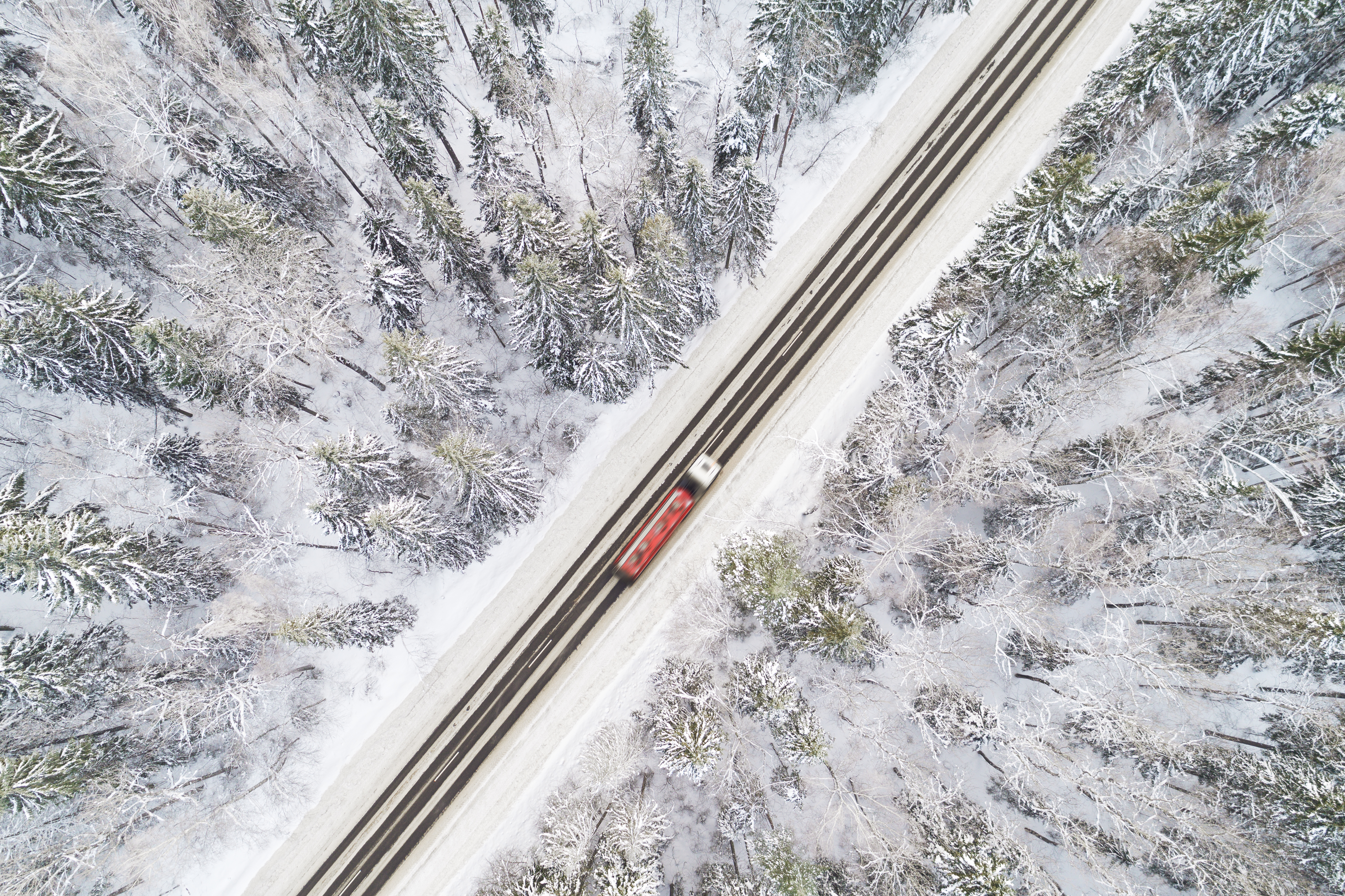
Miranda Blake
En lastbilchaufførs guide til vinteren i Europa
Oprettet: 16.10.2024
•
Opdateret: 23.12.2025
Lastbilchauffører står over for et unikt sæt udfordringer og ansvar i de kolde årstider. Der er en stigning i alvorlige trafikulykker, hvor [33 % af forsikringskravene i denne periode anses for at være alvorlige] (https://atha.co.uk/news/why-you-are-more-likely-to-have-a-severe-road-traffic-accident-in-the-winter).
Og derfor er forberedelse afgørende. Her guider vi til, hvordan lastbilchauffører kan være sikre både på vejen og inde i førerhuset denne vinter.
At navigere i stormfulde forhold
Det er vigtigt at køre langsomt og holde en sikker afstand til andre køretøjer - især i oversvømmede områder. Du bør sætte din bil i lavt gear og holde motoren i gang.
Følgende tips vil også hjælpe med at køre i stormvejr.
- Hvis du mister kontrollen på vandoverfladen, skal du sænke farten ved at slippe foden fra speederen - forsøg ikke at bremse eller styre pludseligt.
- Højere køretøjer er mere sårbare over for kraftig vind - sørg for at holde godt fast i rattet og undgå broer, hvor det er muligt.
- Kør med åbne gardinsider, hvis din lastbil er tom. På den måde er der mindre at fange i vinden.
Håndtering af sne og is
At køre med nedsat hastighed og holde den nødvendige afstand til den forankørende er også noget, man bør gøre, når der er is og sne. Faktisk anbefales det, at du øger bremselængden til 10 gange den normale afstand - men det kan være svært at bedømme. En Admiral-undersøgelse viste, at [sort is forårsager 10 % af ulykkerne om vinteren] (https://atha.co.uk/news/why-you-are-more-likely-to-have-a-severe-road-traffic-accident-in-the-winter). Du kan se, om du kører på sort is, hvis vejen ser våd ud, men der ikke kommer sprøjt fra andre køretøjer.
Andre tips, der kan hjælpe dig med at køre i sneen, omfatter regelmæssige eftersyn af bilen og sikring af, at du har alt det nødvendige udstyr inden turen, f.eks. startkabler og afisningsværktøj. Desuden skal du altid være opmærksom på, hvilket gear du bør køre i, da det kan forhindre dig i at miste kontrollen over din lastbil. På flade overflader skal du køre i det højest mulige gear. Når det går ned ad bakke, skal du bruge motorbremsen og køre i lave gear. For at undgå hjulspind skal du bruge et højere gear, når du trækker væk - det giver dig den trækkraft, der er nødvendig for at flytte køretøjet.

Sikring af synlighed
Med farlige motorveje og eksterne faktorer, der påvirker synet negativt og forårsager lastbilulykker, er udsynet afgørende i al slags vejr, især når det er køligere. Så sørg for at tjekke, om der er stenslag eller revner i forruden, da de kan sprede sig hurtigere i de kolde måneder.
Derudover vil du gerne have det højeste niveau af synlighed for dine lygter, nummerplade og forrude. Ud over at fjerne sne og snavs er det klogt at vaske bilen regelmæssigt for at undgå, at der samler sig vejsalt (det udløser korrosion).
Hvis sigtbarheden er dårlig, og forholdene bliver forræderiske, er det bedst at køre af vejen og tage et hvil på den nærmeste rasteplads. Hvis du bliver nødt til at overskride dine [køretimer] (https://snapacc.com/newsroom/discover-the-new-drivers-hours-rules/), kan du bruge en særlig dispensation til chauffører, der sidder fast under unikke omstændigheder som f.eks. ekstreme vejrforhold.
Vurdering af dækkets mønsterdybde
Lave temperaturer kan også påvirke dine dæks funktionalitet, da de kan udløse et reduceret lufttryk. Og da slidte dæk desværre forlænger bremselængden og reducerer stabiliteten på våde og isglatte veje, vil den lave slidbane medføre udskridning.
Derfor er det en god idé at tjekke mønsterdybden før hver tur i storm og andre barske forhold - på den måde er du klar over, hvornår du skal håndtere eventuelle problemer, der opstår.
Følg reglerne for vinterdæk
Det er også vigtigt at kende til de forskellige regler for vinterdæk. I nogle lande skal bilisterne have sandsække og skovle med, mens snekæder er obligatoriske i andre. Continental har samlet en enkel [guide til kravene til vinterdæk] (https://www.continental-tyres.co.uk/b2c/tyre-knowledge/winter-tyre-laws/) for Storbritannien og Europa.
Fra 1. november er vinterdæk obligatoriske i:
- Østrig
- Tjekkiet
- Finland
- Frankrig
- Litauen
- Serbien
I andre lande er de obligatoriske senere på måneden eller i december, eller de er afhængige af vejrforholdene. Hvad angår pigdæk, så er de tilladt i nedenstående lande, men der er strenge regler omkring dem. Det er bedst at tjekke reglerne for hvert enkelt land inden rejsen.
- Østrig
- Hviderusland
- Danmark
- Estland
- Finland
- Frankrig
- Storbritannien
- Letland
- Liechtenstein
- Litauen
- Norge
- Spanien
- Sverige
- Schweiz
- Tyrkiet
- Ukraine
Medbring relevante forsyninger
Du skal også tænke på, hvordan du kan passe på dig selv om vinteren. Det lyder indlysende, men sørg for, at du har adgang til tilstrækkeligt med mad og drikke. Da der er større risiko for lukkede veje i den kolde årstid, er det ikke altid, du kan nå frem til en rasteplads. Kom forberedt med snacks eller måltider og gerne en varm drik i en lommelærke.
Især hvis du ikke har adgang til et sted at hvile, skal du sørge for at kunne holde varmen. Tag f.eks. genopladelige varmepakker med. Hav også altid varmt og ekstra tøj ved hånden; det er især nyttigt, hvis tøjet bliver koldt og vådt under opgaver som f.eks. at fjerne sne fra din forrude.
Ideelt set har du en vinteroverlevelsespakke - bestående af mad, drikke, en bærbar telefonoplader, en lommelygte, tæpper, en sikkerhedsvest, en skovl og slidstærke vandresko.
Garanteret adgang til rastepladser med intruck
Vejret er ikke under din kontrol, men det er det at beskytte dig selv og andre på vejen. Det betyder bl.a., at du skal sørge for at have et sikkert sted at parkere så hurtigt som muligt. Vores intruck-app eller [kortside] (https://snapacc.com/map/) fortæller dig om tjenesteudbydere i nærheden sammen med oplysninger om de faciliteter, de hver især tilbyder.
Du kan downloade intruck-appen i dag ved at klikke på [dette link] (https://intruckapp.com/download/).



